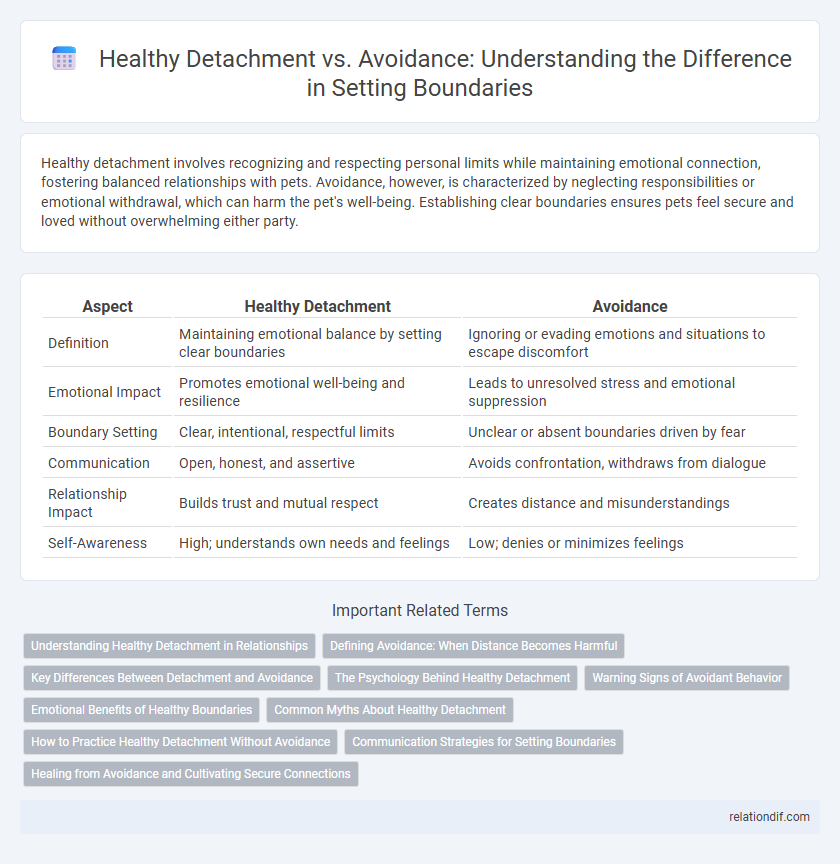Healthy detachment involves recognizing and respecting personal limits while maintaining emotional connection, fostering balanced relationships with pets. Avoidance, however, is characterized by neglecting responsibilities or emotional withdrawal, which can harm the pet's well-being. Establishing clear boundaries ensures pets feel secure and loved without overwhelming either party.
Table of Comparison
| Aspect | Healthy Detachment | Avoidance |
|---|---|---|
| Definition | Maintaining emotional balance by setting clear boundaries | Ignoring or evading emotions and situations to escape discomfort |
| Emotional Impact | Promotes emotional well-being and resilience | Leads to unresolved stress and emotional suppression |
| Boundary Setting | Clear, intentional, respectful limits | Unclear or absent boundaries driven by fear |
| Communication | Open, honest, and assertive | Avoids confrontation, withdraws from dialogue |
| Relationship Impact | Builds trust and mutual respect | Creates distance and misunderstandings |
| Self-Awareness | High; understands own needs and feelings | Low; denies or minimizes feelings |
Understanding Healthy Detachment in Relationships
Healthy detachment in relationships involves maintaining emotional balance by setting clear boundaries that protect individual well-being without shutting down communication or intimacy. It encourages self-awareness and respect for personal limits, allowing partners to connect authentically while preserving independence. Unlike avoidance, healthy detachment supports conscious engagement and emotional regulation, fostering sustainable and mature relationships.
Defining Avoidance: When Distance Becomes Harmful
Avoidance occurs when physical or emotional distance is used to escape uncomfortable feelings or conflicts, leading to unresolved issues and emotional disconnection. Unlike healthy detachment, which maintains clear boundaries while allowing engagement and understanding, avoidance fosters isolation and undermines relationship growth. Recognizing when distance shifts from protective to harmful is essential for emotional well-being and maintaining authentic connections.
Key Differences Between Detachment and Avoidance
Healthy detachment involves consciously setting emotional boundaries to maintain well-being while staying engaged in relationships, whereas avoidance is characterized by evading or neglecting issues to escape discomfort. Detachment supports resilience and self-awareness, promoting constructive interactions, while avoidance undermines connection and often leads to unresolved conflicts. Understanding these distinctions is crucial for fostering emotional balance and effective relationship management.
The Psychology Behind Healthy Detachment
Healthy detachment involves maintaining emotional boundaries that allow individuals to engage with others without losing their sense of self, promoting psychological resilience and well-being. It differs from avoidance, which is characterized by evading emotional connections and responsibilities, often leading to increased anxiety and relational difficulties. Psychological research highlights that healthy detachment supports adaptive coping mechanisms, enhances emotional regulation, and fosters autonomy within interpersonal relationships.
Warning Signs of Avoidant Behavior
Warning signs of avoidant behavior include consistent emotional withdrawal and reluctance to engage in meaningful conversations, which undermine healthy detachment's balance. Individuals exhibiting avoidant tendencies often neglect personal boundaries by dismissing necessary communication and intimacy. Recognizing patterns such as chronic evasiveness and discomfort with vulnerability helps distinguish unhealthy avoidance from constructive emotional distance.
Emotional Benefits of Healthy Boundaries
Healthy boundaries foster emotional resilience by promoting self-awareness and reducing stress, which prevents codependency and burnout. They enable individuals to engage authentically in relationships while preserving personal space and mental well-being. Establishing these limits enhances emotional regulation, leading to increased self-esteem and healthier interpersonal dynamics.
Common Myths About Healthy Detachment
Healthy detachment involves maintaining emotional boundaries while staying connected, whereas avoidance reflects fear and unwillingness to face issues. Common myths include believing detachment means emotional coldness or complete disconnection, which misunderstands its role in fostering resilience. Recognizing healthy detachment as a balanced approach promotes mental well-being and stronger relationships.
How to Practice Healthy Detachment Without Avoidance
Practicing healthy detachment involves acknowledging emotions without suppressing or ignoring them, allowing space for thoughtful reflection and personal growth. Setting clear boundaries supports this process by maintaining emotional balance and preventing codependency or overwhelm. Engaging in mindfulness techniques and open communication fosters healthy detachment, distinguishing it from avoidance which often leads to emotional disconnection and unresolved conflicts.
Communication Strategies for Setting Boundaries
Effective communication strategies for setting boundaries emphasize clarity and assertiveness without hostility, ensuring both parties understand limits while maintaining respect. Using "I" statements fosters personal accountability and reduces defensiveness, which distinguishes healthy detachment from avoidance by promoting honest dialogue rather than evasion. Setting firm yet flexible boundaries enables individuals to protect their well-being while encouraging open interaction and mutual understanding.
Healing from Avoidance and Cultivating Secure Connections
Healthy detachment involves recognizing personal limits and maintaining emotional balance without shutting down or withdrawing from relationships. Healing from avoidance requires confronting fears of intimacy and practicing vulnerability to rebuild trust and connection. Cultivating secure connections depends on consistent communication, empathy, and respecting boundaries while fostering emotional safety.
Healthy detachment vs avoidance Infographic

 relationdif.com
relationdif.com